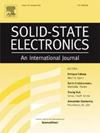Performance of Pulse-Programmed memristive crossbar array with bimodally distributed stochastic synaptic weights
IF 1.4
4区 物理与天体物理
Q3 ENGINEERING, ELECTRICAL & ELECTRONIC
引用次数: 0
Abstract
In this paper, we present a method of implementing memristive crossbar arrays with bimodally distributed weights. The bimodal distribution is a result of pulse-based programming. The memristive devices are used for implementing synaptic weights and can only have an ON (logical “1″) or an OFF (logical ”0″) state. The state of the memristive device after programming is determined by the bimodal distribution. The highly efficient noise-based variability approach is used to simulate this stochasticity. The memristive crossbar array is used to classify the MNIST data set and comprises more than 15,000 weights. The interpretation of these weights is investigated. In addition, the influence of the stochasticity of the weights and the accuracy of the weights on the classification results is considered and various programming settings are examined.
具有双峰分布随机突触权的脉冲编程记忆栅阵列的性能
本文提出了一种实现权值为双峰分布的记忆交叉棒阵列的方法。双峰分布是基于脉冲规划的结果。忆阻器件用于实现突触权重,并且只能具有ON(逻辑“1″”)或OFF(逻辑“0″”)状态。编程后记忆器件的状态由双峰分布决定。采用高效率的基于噪声的可变性方法来模拟这种随机性。记忆交叉棒阵列用于对MNIST数据集进行分类,包含超过15,000个权重。对这些权重的解释进行了研究。此外,还考虑了权重的随机性和权重的准确性对分类结果的影响,并对各种编程设置进行了检验。
本文章由计算机程序翻译,如有差异,请以英文原文为准。
求助全文
约1分钟内获得全文
求助全文
来源期刊

Solid-state Electronics
物理-工程:电子与电气
CiteScore
3.00
自引率
5.90%
发文量
212
审稿时长
3 months
期刊介绍:
It is the aim of this journal to bring together in one publication outstanding papers reporting new and original work in the following areas: (1) applications of solid-state physics and technology to electronics and optoelectronics, including theory and device design; (2) optical, electrical, morphological characterization techniques and parameter extraction of devices; (3) fabrication of semiconductor devices, and also device-related materials growth, measurement and evaluation; (4) the physics and modeling of submicron and nanoscale microelectronic and optoelectronic devices, including processing, measurement, and performance evaluation; (5) applications of numerical methods to the modeling and simulation of solid-state devices and processes; and (6) nanoscale electronic and optoelectronic devices, photovoltaics, sensors, and MEMS based on semiconductor and alternative electronic materials; (7) synthesis and electrooptical properties of materials for novel devices.
 求助内容:
求助内容: 应助结果提醒方式:
应助结果提醒方式:


